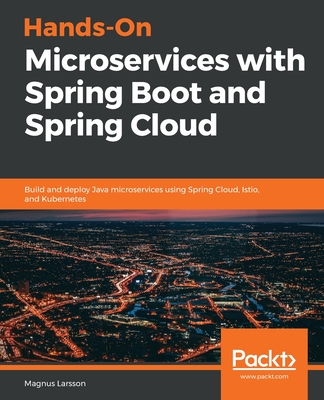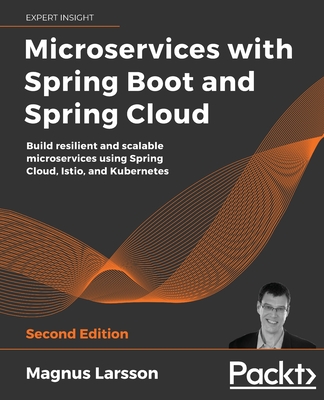Hands-On Microservices with Kotlin: Build reactive and cloud-native microservices with Kotlin using Spring 5 and Spring Boot 2.0
暫譯: 實作微服務與 Kotlin:使用 Spring 5 和 Spring Boot 2.0 建立反應式及雲端原生微服務
Juan Antonio Medina Iglesias
- 出版商: Packt Publishing
- 出版日期: 2018-01-25
- 售價: $1,800
- 貴賓價: 9.5 折 $1,710
- 語言: 英文
- 頁數: 414
- 裝訂: Paperback
- ISBN: 1788471458
- ISBN-13: 9781788471459
-
相關分類:
Microservices 微服務
海外代購書籍(需單獨結帳)
商品描述
Build smart, efficient, and fast enterprise-grade web implementation of the microservices architecture that can be easily scaled.
Key Features
- Write easy-to-maintain lean and clean code with Kotlin for developing better microservices
- Scale your Microserivces in your own cloud with Docker and Docker Swarm
- Explore Spring 5 functional reactive web programming with Spring WebFlux
Book Description
With Google's inclusion of first-class support for Kotlin in their Android ecosystem, Kotlin's future as a mainstream language is assured. Microservices help design scalable, easy-to-maintain web applications; Kotlin allows us to take advantage of modern idioms to simplify our development and create high-quality services. With 100% interoperability with the JVM, Kotlin makes working with existing Java code easier. Well-known Java systems such as Spring, Jackson, and Reactor have included Kotlin modules to exploit its language features.
This book guides the reader in designing and implementing services, and producing production-ready, testable, lean code that's shorter and simpler than a traditional Java implementation. Reap the benefits of using the reactive paradigm and take advantage of non-blocking techniques to take your services to the next level in terms of industry standards. You will consume NoSQL databases reactively to allow you to create high-throughput microservices. Create cloud-native microservices that can run on a wide range of cloud providers, and monitor them. You will create Docker containers for your microservices and scale them. Finally, you will deploy your microservices in OpenShift Online.
What you will learn
- Understand microservice architectures and principles
- Build microservices in Kotlin using Spring Boot 2.0 and Spring Framework 5.0
- Create reactive microservices that perform non-blocking operations with Spring WebFlux
- Use Spring Data to get data reactively from MongoDB
- Test effectively with JUnit and Kotlin
- Create cloud-native microservices with Spring Cloud
- Build and publish Docker images of your microservices
- Scaling microservices with Docker Swarm
- Monitor microservices with JMX
- Deploy microservices in OpenShift Online
Who This Book Is For
If you are a Kotlin developer with a basic knowledge of microservice architectures and now want to effectively implement these services on enterprise-level web applications, then this book is for you
Table of Contents
- Understanding Microservices
- Getting Started with Spring Boot 2.0
- Creating RESTful services
- Creating Reactive Microservices
- Reactive Spring Data
- Creating Cloud Native Microservices
- Creating Dockers
- Scaling Microservices
- Testing Spring Microservices
- Monitoring Microservices
- Deploying Microservices
- Best Practices
商品描述(中文翻譯)
**建立智能、高效且快速的企業級微服務架構網頁實作,易於擴展。**
#### 主要特點
- 使用 Kotlin 編寫易於維護的精簡且乾淨的代碼,以開發更好的微服務
- 在自己的雲端中使用 Docker 和 Docker Swarm 擴展微服務
- 探索 Spring 5 的功能性反應式網頁編程,使用 Spring WebFlux
#### 書籍描述
隨著 Google 在其 Android 生態系統中對 Kotlin 的一流支持,Kotlin 作為主流語言的未來已經得到保障。微服務有助於設計可擴展、易於維護的網頁應用程式;Kotlin 使我們能夠利用現代語法簡化開發並創建高品質服務。Kotlin 與 JVM 具有 100% 的互操作性,使得與現有 Java 代碼的協作變得更加容易。知名的 Java 系統如 Spring、Jackson 和 Reactor 已經包含了 Kotlin 模組,以利用其語言特性。
本書指導讀者設計和實現服務,並生成可生產、可測試的精簡代碼,這些代碼比傳統的 Java 實現更短且更簡單。利用反應式範式的優勢,採用非阻塞技術,將您的服務提升到行業標準的下一個層次。您將以反應式方式使用 NoSQL 數據庫,從而創建高吞吐量的微服務。創建可以在各種雲服務提供商上運行的雲原生微服務,並對其進行監控。您將為微服務創建 Docker 容器並進行擴展。最後,您將在 OpenShift Online 部署您的微服務。
#### 您將學到的內容
- 理解微服務架構和原則
- 使用 Spring Boot 2.0 和 Spring Framework 5.0 在 Kotlin 中構建微服務
- 創建執行非阻塞操作的反應式微服務,使用 Spring WebFlux
- 使用 Spring Data 以反應式方式從 MongoDB 獲取數據
- 使用 JUnit 和 Kotlin 進行有效測試
- 使用 Spring Cloud 創建雲原生微服務
- 構建並發布微服務的 Docker 映像
- 使用 Docker Swarm 擴展微服務
- 使用 JMX 監控微服務
- 在 OpenShift Online 部署微服務
#### 本書適合誰
如果您是一位對微服務架構有基本了解的 Kotlin 開發者,並希望在企業級網頁應用程式中有效實現這些服務,那麼本書適合您。
#### 目錄
1. 理解微服務
2. 開始使用 Spring Boot 2.0
3. 創建 RESTful 服務
4. 創建反應式微服務
5. 反應式 Spring Data
6. 創建雲原生微服務
7. 創建 Docker
8. 擴展微服務
9. 測試 Spring 微服務
10. 監控微服務
11. 部署微服務
12. 最佳實踐





















